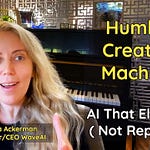In Tokyo right now, an AI can legally train on nearly everything created in Japan - books, songs, artwork - without permission or payment.
This isn't science fiction; it's current Japanese copyright law.
Step outside Japan's borders, and suddenly those same works may gain legal protection. This isn't theoretical - it's playing out in courtrooms today.
The story of Ultraman - one of Japan's superheroes - represents this contradiction. In a Chinese courtroom, this Japanese character won a copyright battle against AI.
Yet back home in Japan, that same AI use – for training - would be completely legal.
This isn't about superheroes and science fiction.
It's about your work becoming someone else's fuel, with different rules depending on which digital border you cross.
Because Japan’s AI and China’s AI and the US’s AI….countries will probably have their own, as well as their own copyright rules.
In 2025, we're witnessing the emergence of AI zones - digital territories where copyright means different things in different places.
There won't be one global system, it’s a patchwork of nationalistic and cultural points of view.
What Japan's model reveals isn't just a legal curiosity - it's a potential future we're all heading toward, where content flows freely into AI within certain boundaries, but with protection against direct copying or financial harm.
When your work can travel anywhere but the rules protecting it cannot, you need to understand the global rules - not just your local square.
The AI Wrapper Not the Site: What Creators Learn from Ultraman
When you're fighting AI copyright violations, you need to know where your content is located. Except now it’s all tokens and math.
Only thing to do is try to recreate what went in….
A Chinese licensing company (SCLA) owns Ultraman rights in China. They found their character being generated by an AI system.
They took legal action against the website where users could enter "Ultraman DYNA" and get images that clearly resembled their licensed character.
They won - but they didn't actually solve the problem.
Because they targeted the website, not the AI system feeding it. Where the Ultraman imagery still resides.
This matters for creators because:
Many AI websites are "wrappers" - they don't own or train the AI models
They're paying monthly fees to connect their site to third-party AI via APIs
The Ultraman images are still in the AI's training data, even after the lawsuit
The court couldn't remove what wasn't part of the case
When you use a site with AI features, chances are they're just an interface connecting to models built elsewhere (obvious for people in AI, surprisingly not for many who are not familiar).
For creators standing up for their work, this means tracking the data to its source.
Don't just go after the visible website - follow where your tool gets its training data. Otherwise, you'll win the small battle and your content will still be able to be reproduced.
And as mentioned everywhere, no one is sure they could actually pull your content out of AI, because your content isn’t your content anymore.
Do AI Tools Really Need Artists?
Witness Japan's approach to copyright and you might wonder if AI needs any help. Their system allows AI to train on copyrighted works, but with guardrails that might surprise you.
AI working with creators, like software developers have for years.
Adobe Firefly, trained on licensed stock, gains widespread adoption among professionals
Sony's Flow Machines co-creates with artists, sidestepping legal battles
Midjourney asks users for feedback and allows creation of mood boards to improve its systems
I'm not even close to being good on Midjourney, but it ups my game tremendously by providing tools smarter than I am as a novice graphic designer.
That's not replacement - that's enhancement. Always asking for feedback like a strong AI startup.
Despite drawing a line in the sand with copyright, that same line may bring us together.
The Japanese experiment recognizes a fundamental truth:
AI gets better when humans remain in the loop not just as data sources, but as active participants.
The question isn't whether AI needs artists - it's how we structure that relationship to benefit both.
As much as we might want to keep separate worlds, the evidence shows this is where AI gets good - when it learns with us, not just from us.
2 Parts of Japan's AI Copyright rules
The Blueprint Behind Japan's AI Freedom
What makes these AI tools work isn't just tech brilliance - it's the legal framework supporting them. Looking at Japan's approach reveals something engineers have been arguing for: a system where AI learns from everything while still respecting creators' rights.
Japan's copyright rules for AI rest on two key pillars that balance progress with protection:
The Non-Enjoyment Purpose Requirement
The first pillar is simple: intention matters. Japan allows copyrighted content to train AI systems if the purpose isn't to recreate the original work.
You're not bringing in Van Gogh paintings to create more Van Goghs - you're bringing them in to help the AI understand artistic styles, composition, and color theory.
This creates breathing room for AI development while maintaining a boundary around blatant copying. The focus isn't on inputs but outcomes.
While this sounds straightforward, it creates real questions for creators: how do you distinguish between "learning from" and "copying" in a practical sense? This leads to Japan's second pillar.
Article 34 Proviso: Where Protection Lives
Japan doesn't leave creators without protection. Their Article 34 Proviso acts as a safety net, establishing that if AI output causes actual harm to a creator's career, reputation, or financial status, normal copyright protections kick in.
This practical approach says: let data flow into AI systems, but watch carefully what comes out. If the output creates direct competition or damages creators, that's where the line gets drawn.
Fair Use and Japan's AI Freedom - not the same
How different Japan's approach is from the U.S. "fair use" defense - both trying to solve the same problem.
In the U.S., fair use isn't a rule - it's a legal defense. You only know if something is fair use after you've been sued, and a court decides. It's reactive, not proactive.
In Japan, they've built a system that's more predictable. AI companies know upfront what's permitted: training is allowed, copying isn't.
Creators know where their protection lies: not in restricting input, but in preventing harmful output.
This is what many U.S. engineers are actually arguing for when they claim fair use. They're saying:
"We're not taking content to reproduce it - we're taking it to learn patterns, just like Japan allows."
Both agree, what comes out matters more than what goes in. If the output looks like what went in, both countries consider that a violation.
As we move through 2025, the U.S. Copyright Office findings will shape everything.
I suspect we'll see something like Japan's system emerge - allowing inputs for learning and focusing protection on outputs causing real harm.
The "Human-AI Collaboration" Spectrum
I'm amazed the US Copyright Office didn't simply declare all content suitable for AI training. By leaving it open, we're in this year-long limbo - but I can't imagine they'll crush ChatGPT, Claude, and the entire AI industry with a finding against it.
What we're likely to see instead is a spectrum of human-AI collaboration, with different levels of protection based on human involvement.
This isn't just speculation - it's already happening in courts across the world, including Japan and China.
At one end of the spectrum, you have minimal input - dropping in a prompt or two and accepting whatever comes out.
Courts are already signaling this won't qualify for copyright protection.
On the other end, iterative creation - refining, directing, and shaping the AI's output through rounds of feedback.
The courts are looking for evidence of your creative process - not just that you typed "Ultraman DYNA" and grabbed the first image.
They want to see focused human effort with the tool, making deliberate choices, and guiding it toward your vision.
What's emerging isn't binary (all human vs. all AI) but where protection increases with human involvement.
The U.S. Copyright Office is likely heading toward a similar model - not copying Japan, it reflects the reality of how we're both using these tools.
Concept and Direction? Prove it!
So what does meaningful human input actually look like in practice? Two words are becoming crucial: concept and direction.
Courts are looking for evidence that you had a concept in mind before approaching AI. Did you have an intention, a vision, a goal?
Or were you just fishing for whatever the AI might generate?
This matters because intention shows you're bringing something original to the table - not just activating a random content generator.
Direction is equally important - can you demonstrate how you guided the AI toward your vision?
This means showing your creative choices - whether that's choosing specific platforms, curating between different AI outputs, adjusting colors, angles, or filters.
You need to show more than just button-pressing.
I've noticed the U.S. Copyright Office repeatedly questioning whether works were "just done by AI" - and without evidence of human direction, they're likely to deny protection.
The more you can document your process - showing your inputs, revisions, selections, and edits - the stronger your claim to copyright protection becomes.
The real question isn't whether AI was involved - it's whether a human mind was driving the creative process rather than following it.
No Easy Answers for AI - finding your way
Just like that Chinese court in the Ultraman case, there are no easy answers here.
While they found for the license owner, it was a minimal fine that didn't actually stop the problem.
Not because the court was wrong, but because the plaintiff didn't understand where the real infringement occurred - in the AI's training data, not just on the website.
Most people listening right now probably don't understand the technical architecture I just described - how websites are often just interfaces connecting to third-party AI systems.
This disconnect between what we see and how things actually work creates problems for copyright enforcement.
So where does that leave creators? Four principles can guide you forward:
First, understand that there's no going back. The genie is out. AI has seen the work of humanity and will continue to learn from it.
Second, document everything. If you're creating with AI assistance, maintain records of your process. Save your prompts, iterations, editing decisions, and selection criteria. This evidence of your creative direction will become increasingly valuable.
Third, focus on curation and assembly. Even as individual elements become easier to generate, the thoughtful selection and organization of those elements remains distinctly human.
Copyright protection for compilations and collections is well-established, even when the pieces themselves might not qualify.
Finally, embrace the spectrum. The future isn't binary - AI or human. It's finding the sweet spot where technology amplifies your creativity rather than replacing it.
The most successful creators won't be those who avoid AI entirely, nor those who rely on it completely, but those who learn to dance with it.
As much as we've drawn copyright as a line in the sand, it can bring us together - forcing creators and engineers to find mutual solutions rather than mutual destruction.
The Japanese experiment offers a glimpse of what's possible:
a system that acknowledges both our collective interest in advancing AI and our individual interests in protecting creative work.
No court decision will provide perfect clarity.
No copyright ruling will solve every problem.
By focusing on what we can control - our own creative processes, documentation, and adapting - while continuing to create work that matters.
Resources
Chinese Court Issues First Decision on AI Copyright Infringement
China’s First Case on AIGC Output Infringement--Ultraman
28 February 2024
Report on AI and Copyright Issues by Japanese Government
NO&T IP Law Update
27th_Tokyo_International_Film_Festival_Ultraman_from_Ultraseven_(15001540863)
By Dick Thomas Johnson from Tokyo, Japan - 27th Tokyo International Film Festival: Ultraman from Ultraseven, CC BY 2.0, https://commons.wikimedia.org/w/index.php?curid=118426646
By Dick Thomas Johnson from Tokyo, Japan - Ultraseven from "ULTRASEVEN 55th Anniversary Special Screening" at Red Carpet of the Tokyo International Film Festival 2022, CC BY 2.0, https://commons.wikimedia.org/w/index.php?curid=124731453




















